Whether planning to renovate an apartment or building a house, people are not most worried about the fact that they will have to part with an impressive amount of money. First of all, they are concerned about the need to choose a material, which today manufacturers offer a huge amount, and a design solution that should make their home as comfortable and beautiful as possible.
This also applies to the kitchen apron. Which one will be the best?
Basic Requirements
In translation from German and Polish, the word "apron" means "hem" or "apron". Already from this it becomes clear that this item is a workwear used to protect against the pollution that always accompanies cooking. It is also used in the kitchen. This room contains the largest concentration of various household appliances, inincluding oven, hob, extractor hood, dishwasher, washing machine, and a wide variety of kitchen appliances and appliances.
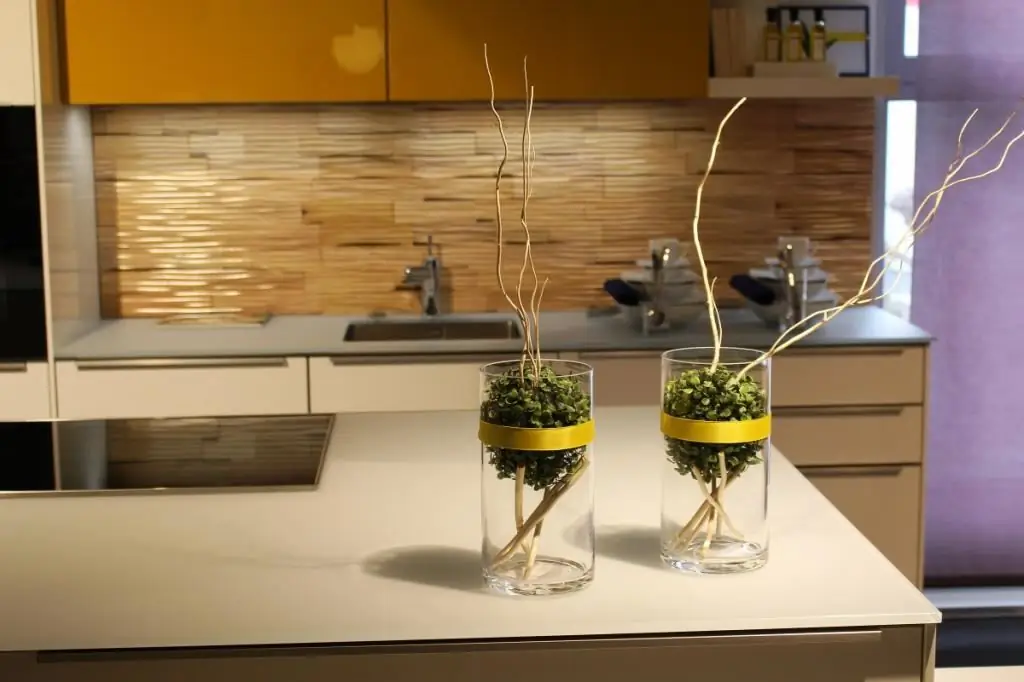
Apron in the interior of the kitchen is one of the most "loaded" elements. First of all, it has a thermal effect from any device turned on by the hostess. And this contributes to the emergence of a large internal mechanical stress in the apron.
In addition, cooking is always accompanied by an increase in humidity in the room, which manifests itself in the form of water vapor, direct exposure to water or its splashes.
Frying and boiling also produce various pollutants. These are products from gas combustion, soot, food particles and aerosol droplets of fat. And even if there is a hood that can eliminate up to 80-90% of such contaminants, the remaining part of them eventually gradually settles on kitchen surfaces in the form of a nasty sticky film, which is quite difficult to remove. All this remains on the kitchen apron.
Also, such a surface sometimes experiences direct mechanical impacts from impacts from kitchen appliances, dishes or any heavy objects. Micro-scratches constantly appear on it, which leave the abrasive components of cleansers.
Based on this, you can decide which apron for the kitchen is better. It must be made of a material that is durablewill tolerate temperature effects, be moisture and water resistant, chemically inert to compounds that occur during cooking, cleaning and washing dishes. It is also necessary that the surface of the kitchen apron is wear-resistant and durable, does not emit harmful substances, and can be easily cleaned of dirt.
For owners planning repairs, it is important that this surface is fairly easy to install and has a very reasonable final price. Need an apron and an attractive appearance.
As you can see, the list of requirements for this surface is quite impressive. How to make an apron for the kitchen? And what material to use for it?
Painting
There is the most budgetary version of the apron for the kitchen, which was widely used in new buildings built during the USSR. It was an ordinary wall painted with oil paint.
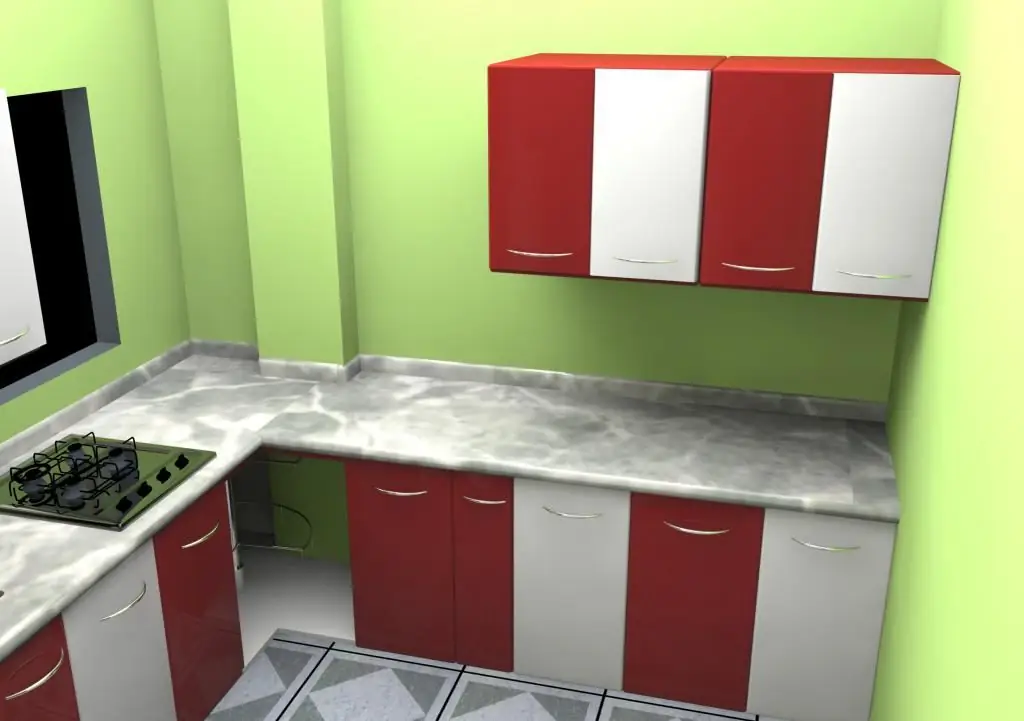
But some owners tried to decorate their kitchen by gluing oilcloth to the wall imitating tiles. We althy people tiled the space under the apron, and sometimes even the entire wall or kitchen room with ceramic tiles. It has not lost its relevance today.
Ceramic tile apron
This material has been known since time immemorial. In ancient times, it was used to decorate palaces, temples, as well as houses that belonged to rich people. However, as technology has improved, ceramic tiles have become moreaffordable at its cost. That is why it began to be used in the decoration of public, industrial, and residential premises.
And if white tiles were previously used on the apron, today you can choose this material from a fairly wide range of colors. Among the advantages of such material are the following:
- Staying on top of fashion trends.
- High mechanical strength.
- Moisture, water and vapor resistance.
- No dependence on temperature.
- Chemical inert and environmentally friendly, with the exception of the absorption of a wide variety of unwanted substances.
- Easy to clean with regular detergents.
- Long service life of 15 to 20 years.
- A wide range of materials of various textures, sizes, colors, as well as the presence of decorative elements, which allows you to develop any design of an apron for the kitchen that will perfectly fit into any interior.
Ceramic tiles have their drawbacks. This is:
- need for preliminary preparation of the wall surface, which must be absolutely flat;
- wall leveling and tiling should not be carried out in the presence of kitchen furniture, as they are "wet";
- need to invite a specialist tiler who charges a considerable price for his services;
- the presence of seams between tiles, which are considered a weak pointan apron where moisture can penetrate and where mold or fungus can form (special grouts will be required to protect the seams);
- high cost of quality material, and especially patterned ceramic tiles for the kitchen and decorative elements - borders and friezes.
As you can see, ceramic tile apron has more advantages than disadvantages. That is why, when planning a major overhaul in the kitchen, it is worth considering this particular finishing option. And even though it will cost the owners more than other types of aprons, the high price will certainly be offset by a long service life.
Porcelain apron
This material is more expensive than ceramic tiles, but it has a lot of positive qualities. First of all, they are in its high strength. In this regard, porcelain stoneware better tolerates temperature changes and mechanical stress. In addition, he painted not only the top layer, but the entire structure. This allows the material to be more resistant to abrasion.
Porcelain stoneware also has lower water absorption than ceramic tiles, which is a big plus for the kitchen surface.
How to make an apron from porcelain stoneware? The process of performing wall cladding with this material is quite simple. It is produced in the form of tiles sized 300x300 mm, 400x400mm, as well as 600x600 mm and 1200x300 mm. Due to this, the number of joints on the surface ofstoneware will be small, which is just fine in terms of its practicality.
How to make an apron from this material? To do this, you should carefully prepare the surface for finishing. You will also need to use special adhesives, because the usual ones for this material will not work because of its dense structure.
A porcelain tile backsplash will look amazing in any kitchen. However, it is especially good to combine a matte material with a glossy kitchen set (and vice versa).
Laying a porcelain stoneware kitchen apron will require hiring a highly qualified craftsman. The tile, which has a size of 600x600 mm with a thickness of 10-11 mm, weighs approximately 10 kg. In addition, porcelain stoneware should be corrected very quickly after it is laid on the wall. It literally immediately “sticks” to the adhesive mixture, so it is very difficult to tear it off the wall.
Natural stone apron
Only a we althy person with exquisite taste can become the owner of such a surface. Of course, a stone apron also implies the presence of a stone countertop. And it is installed in kitchen sets made of precious wood.
In most cases, granite 10-20 mm thick is used to make such an apron. This is a magnificent-looking stone, with impressive density and strength, practically does not absorb water.
In addition to granite, the walls are lined with slate, sandstone, quartz, quartzite,bas alt, onyx or marble. These stones have a less dense structure compared to granite, which makes it somewhat more difficult to remove dirt that has appeared from their surface.
Artificial stone apron
How to make an apron that looks as natural as possible without spending a lot of money? In this case, it is worth considering the option of using artificial stone. It is made from acrylic resin, which contains mineral fillers and various coloring elements. Externally, this material is very similar to natural stone. There are no pores in its structure, which allows the apron made from it not to absorb dirt and moisture.
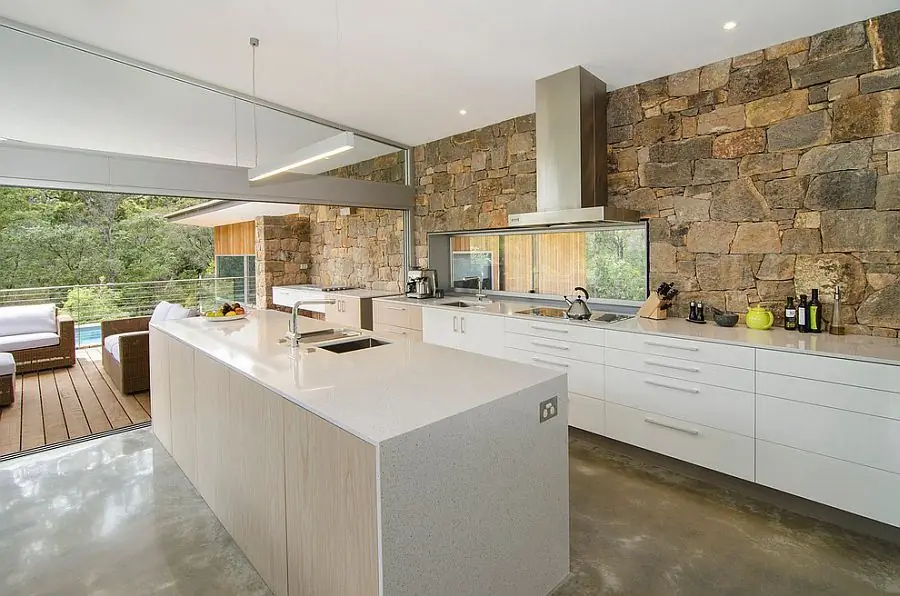
When facing a wall with artificial stone, an almost monolithic surface is formed. This becomes possible due to the good joining of the plates.
Such an apron will serve for a long time, not inferior in this to porcelain stoneware and ceramic tiles. But at the same time, its price is slightly higher than that of these two materials.
Mosaic tile apron
This wall cladding in the kitchen looks quite advantageous, because mosaic aprons can create a unique and very beautiful interior.
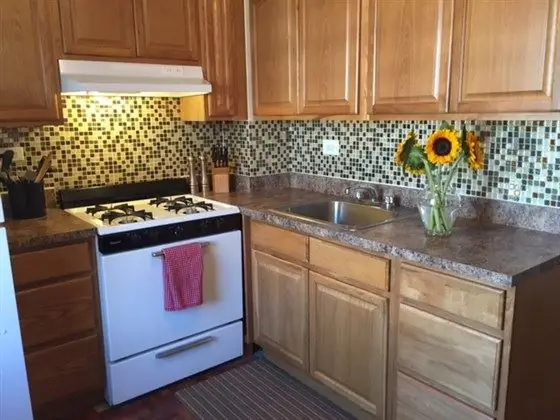
How to make an apron in this type of kitchen? Mosaic laying is a real art, which not every person can master. That is why those owners who choose for themselvesit is this version of the apron that you will need to call the master and decide on the installation method. And she can be:
- Monocore (single color). Such masonry is performed using a mosaic of only one color. However, it is possible to grout in a contrasting or other tone. This apron is perfect for a classic kitchen.
- Mix type. Such styling also involves the use of the same color, but at the same time different shades. Moreover, the more there are, the more interesting the appearance of the apron will become. True, the cost of facing will also increase significantly.
- Gradient. Such styling also involves the use of mosaics of various shades. However, they should not be located randomly, but with the creation of a smooth transition from dark to light and vice versa. Such a “wave” can go both horizontally and along any complex curve.
Sometimes when laying a mosaic, a pattern is created.
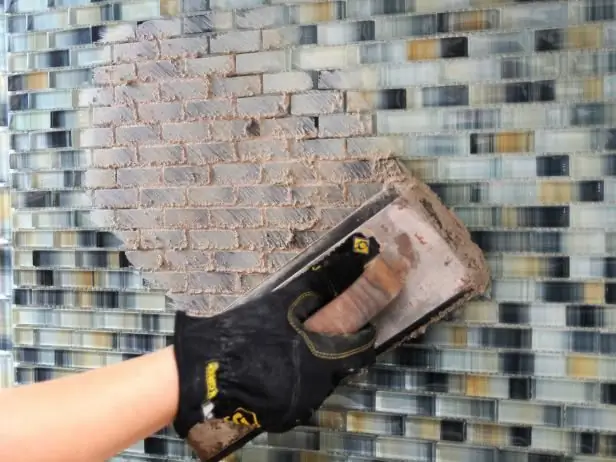
Make it, as a rule, in the interiors of the oriental type. It is also possible to combine mosaics with decorative elements and ceramic tiles.
Aprons from MDF panels
Fibreboard has long been used in the manufacture of furniture facades and wall decoration in rooms. They also find their application in the creation of aprons in kitchens. This material has its undeniable advantages. They are concluded in the following:
- Wide range of colors. Registrationfor tiles, stone or wood allows you to use MDF boards for any interiors.
- Does not require careful surface preparation. Such plates can be installed on a wall that has small irregularities.
- Assembly is not a wet process. This allows you to create an MDF backsplash with the kitchen already installed.
- Mounted quickly enough.
- It has a relatively low cost, which makes it easy for the owners to change this element of the interior.
- With proper care, the apron will last several years.
MDF boards are recommended for those kitchens where cooking is a periodic process.

This material is rather whimsical:
- does not like overheating;
- absorbs water;
- cannot be cleaned with abrasive detergents;
- easily damaged by mechanical impact.
How to make an apron in the kitchen from MDF? You can attach the plates to the wall both on glue and on the crate. The first option is the simplest. For its execution, it is enough to cut the sheets to the required dimensions and apply an adhesive composition along their perimeter. After that, the panels are pressed against the wall and fixed with spacers. 30-45 minutes should elapse before the final setting of the adhesive.
Somewhat more difficult is mounting on the crate. To do this, you need to make a frame, taking bars for it.10x40 mm or 20x40 mm. The material is attached to the wall with dowels. The panels are attached to such a crate with self-tapping screws, the caps of which are masked with decorative caps matched in color. Holes for sockets on such a screen are cut out in advance, and their installation is carried out after the final installation of the plates.
Glass apron
This material is associated by many people with fragility, brittleness and something sharp. However, for a glass kitchen apron, not an ordinary material is chosen, but a hardened one, having a thickness of 6 to 8 mm. It is quite durable and can withstand temperatures up to 300 degrees.
Glass kitchen apron can also be made of triplex. This is a material that consists of two layers glued together with a laminating liquid or a special film.
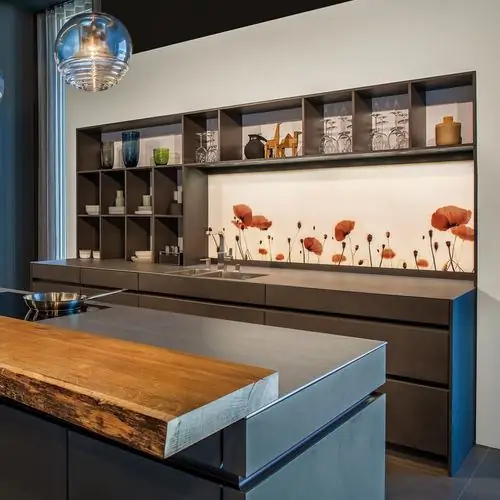
Glasses are glossy, matte, painted in a certain color, colorless, with or without a pattern. The advantages of such aprons are their moisture resistance, chemical inertness, strength, ease of cleaning, original and beautiful appearance. There are only two drawbacks to this material. One of them is the high price, and the second is the risk of destruction under shock loading. However, it should be borne in mind that no traumatic fragments of tempered glass are formed in this case.
To create a glass kitchen apron, it can be attached using one of three methods:
- hinged, involving educationa single protective screen, in which the material is located at a distance of 4 mm from the wall;
- on silicone glue (with small sizes of apron parts);
- using Velcro, which is mounting directly on the wall.
Apron sizes
To clarify the location of the protective surface in the kitchen, you need to have an idea about the arrangement of furniture on it. Better if it is already purchased.
The apron should be located in the space between the bottom surface of the hanging cabinets and the countertop. At the same time, it should go beyond these limits by about 2 cm. As a rule, the distance between the cabinets and the countertop is 60 cm. Based on this, you can calculate the size of the apron in the kitchen. But, in principle, depending on the height of the owners, this distance can be in the range from 45 to 70 cm. This will reduce or increase the size of the apron in the kitchen accordingly.
When using a standard hood over the hob, this cover must be extended in height based on the width of this appliance. The apron should reach the bottom edge of the hood, but it is better if it is laid out to the very ceiling. Behind the side surfaces of the cabinets located in this place, it should be brought at a distance of at least 5 cm.






